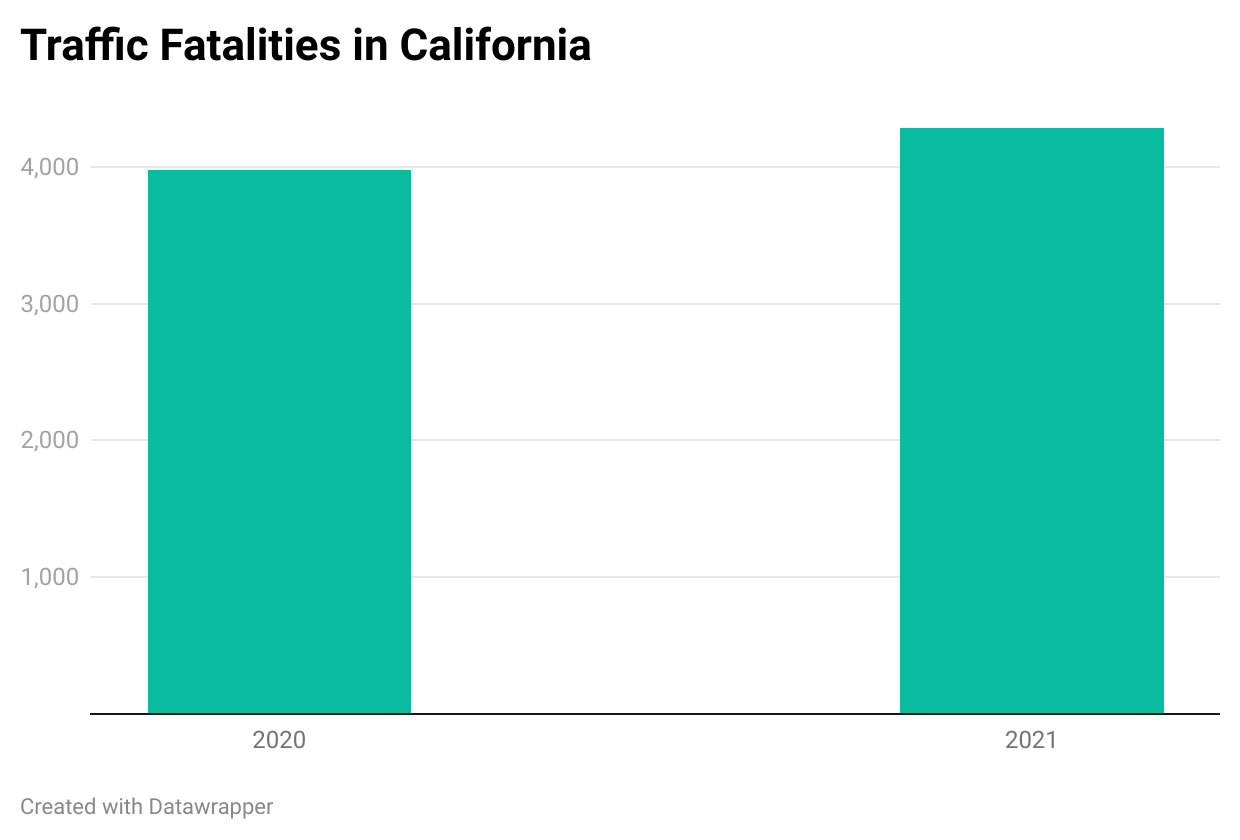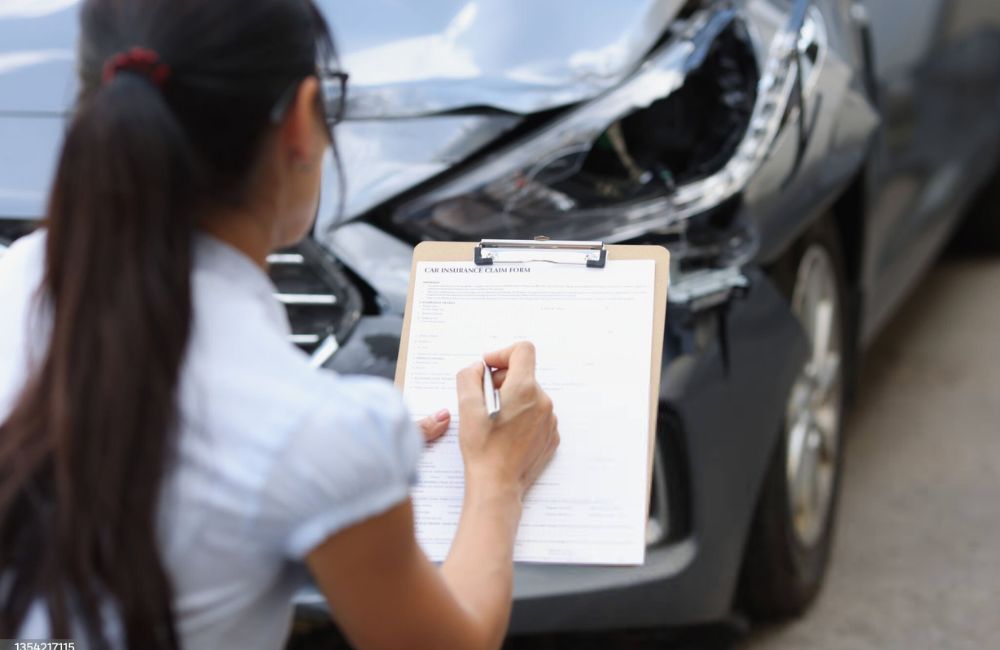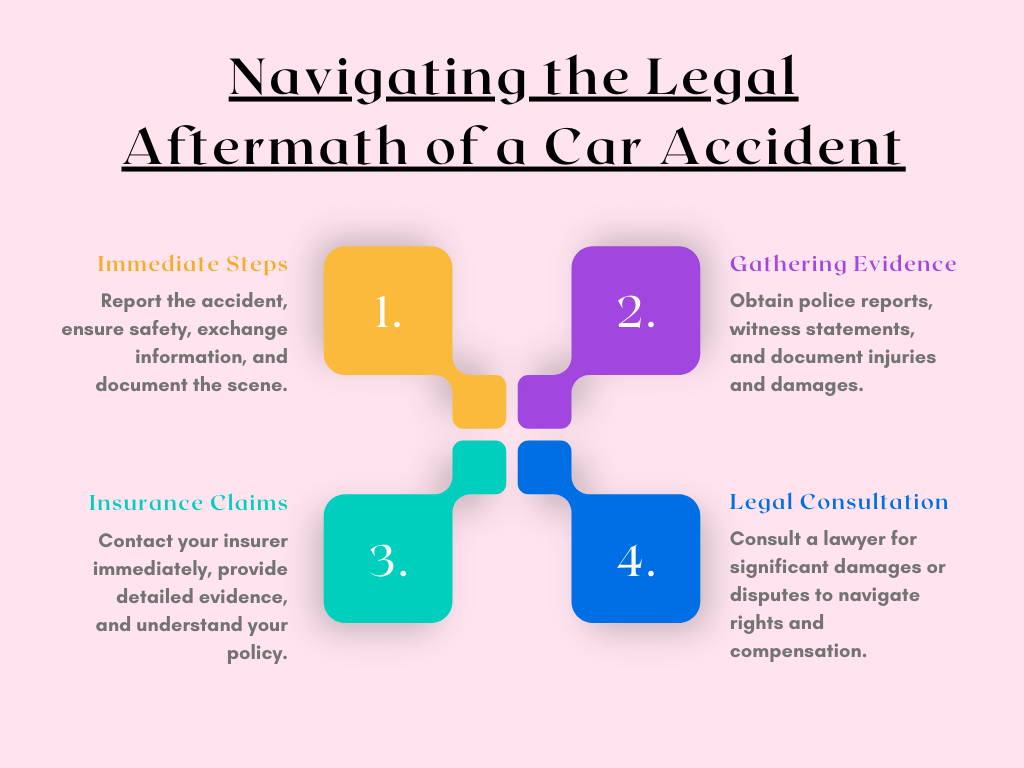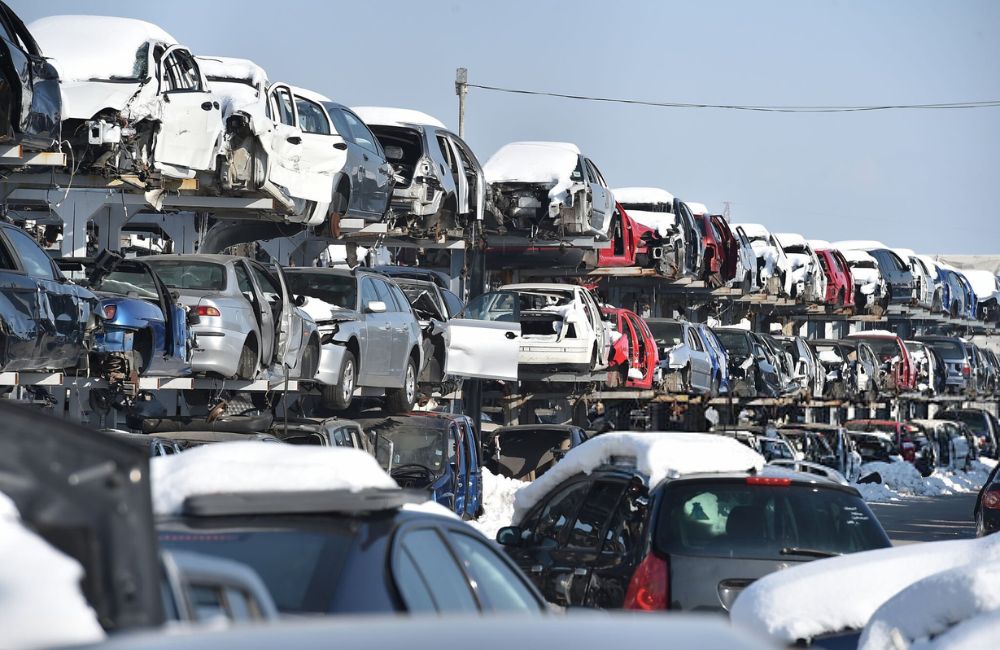The number of car accidents per day in California is a big concern in California, with their far-reaching impacts affecting many aspects of life, from personal health and safety to the broader legal and insurance landscapes.
According to SWITRS, statewide injury crashes increased from 147,148 (403 per day) in 2020 to 160,819 in 2022 (441 per day). Whether you’re driving, in the passenger seat, or simply watching out for others, it’s important to lower risks, handle what comes after an accident, and make sure your rights are looked after. Focusing on staying safe, knowing your legal rights, and seeking justice and money if needed, helps Californians deal with tough situations better.
This article explores the current car crash statistics in California, along with common reasons, legal remedies, and prevention tips to stay safe.
Overview of Car Accidents in California
From 3,980 in 2020 to 4,285 in 2021, there was an approximate 7.6% rise in traffic fatalities. California has seen fluctuating trends in car accidents, with variations in numbers and severity over recent years.
By staying informed about these trends, you can become more aware of the evolving landscape of road safety in the state, helping you navigate the roads with greater caution and informed awareness.


High-Risk Areas and Traffic-Related Factors
Identifying high-risk areas in California and understanding traffic-related factors contributing to accidents can significantly reduce your risk of being involved in a collision. Factors such as congested traffic zones, road construction areas, and intersections with poor visibility play crucial roles in the occurrence of accidents. Awareness of these factors is key to adjusting your driving strategies accordingly.
Common Causes of Car Accidents
The most common causes of car accidents in California include distracted driving, driving under the influence (DUI), and speeding. Recognizing and avoiding these behaviors can drastically lower your chances of an accident. It’s vital to adopt responsible driving habits, such as focusing on the road, adhering to speed limits, and never driving impaired.
Demographics and Risk Factors
Certain demographic groups, including young drivers, elderly drivers, and those driving under the influence, are at a higher risk of being involved in car accidents. By understanding these risk factors, individuals and policymakers alike can target safety measures and educational campaigns more effectively, aiming to protect those most vulnerable on the road.
Laws Covering Car Accidents per Day in California
According to the National Highway Traffic Safety Administration, a total of 3,983 car fatalities per year, or 10.9 daily car crashes on average were recorded in California in 2021. In California, navigating the aftermath of a car accident involves understanding specific legal principles and procedures.
Negligence and Fault Determination in California Car Accidents
In California, establishing who is at fault in a car accident typically revolves around the concept of negligence. If you’re involved in an accident, proving negligence means demonstrating that another driver failed to act with reasonable care, leading to the accident.
This involves showing that the other party had a duty to drive safely, breached that duty, and directly caused your injuries or damages. For you, understanding negligence is crucial, as it directly impacts your ability to recover damages.
California’s Pure Comparative Negligence System
California employs a pure comparative negligence system, which allows you to recover damages even if you are partially at fault for the accident. However, your compensation will be reduced by your percentage of fault. For example, if you are found to be 30% responsible for an accident and the total damages amount to $100,000, you would still be able to recover 70% of the damages, or $70,000. This system ensures that all parties involved are held accountable for their part in the accident, making it essential for you to understand how your actions can affect your compensation.
Reporting Requirements and Legal Procedures Post-Accident
Following a car accident in California, you’re required to report the incident to the DMV within 10 days if there are injuries, fatalities, or property damage exceeding $1,000. Additionally, initiating an insurance claim typically involves notifying your insurance company as soon as possible. Gathering evidence at the scene, such as photos, witness statements, and a copy of the police report, is crucial.
If you’re considering pursuing legal action, consulting with a personal injury lawyer can help navigate the complex legal system and ensure your rights are protected throughout the process. Understanding these procedures is vital for safeguarding your interests after an accident.
Insurance Requirements in California Car Accidents


Navigating the aftermath of a car accident in California involves understanding the state’s insurance requirements and the processes for filing claims. Learning California’s insurance mandates, the common challenges faced when making claims, and tips for handling disputes with insurance companies can improve your well-being as a driver.
California’s Insurance Requirements and the Claims Assessment Process
California law mandates that all drivers carry minimum amounts of liability insurance: $15,000 for injury/death to one person, $30,000 for injury/death to more than one person, and $5,000 for property damage.
When an accident occurs, the claims assessment process begins with the involved parties filing claims with their respective insurance companies. Insurers then evaluate these claims to determine fault and the extent of damages, a process that involves reviewing evidence, police reports, and any applicable legal standards to decide on the compensation due.
Challenges in Insurance Claims
Drivers often encounter challenges such as underinsurance and denial of claims. Underinsurance occurs when the at-fault driver’s insurance coverage is insufficient to cover the damages or medical expenses incurred, potentially leaving victims to cover significant costs. Claim denial, another common issue, can happen for various reasons, including disputes over fault or policy exclusions.
Navigating Disputes with Insurance Companies After a Car Accident
Disputes with insurance companies after a car accident can be daunting. If you find yourself in a disagreement over the settlement offer or claim denial, it’s important to gather all relevant evidence supporting your case, such as medical records and repair estimates.
You may also consider seeking a review of the decision through the insurance company’s internal dispute resolution process. If disputes persist, consulting with a legal professional can provide guidance on your rights and the best course of action, whether it involves further negotiations or taking legal steps to secure the compensation you deserve.
The Personal Injury Center simplifies the process of navigating insurance claims and finding the legal assistance you need. Connect with us so we can partner you with an experienced personal injury lawyer who’s committed to defending your rights and securing the maximum compensation for you.
Compensation in California Car Accidents


Understanding your rights to compensation following a car accident in California is crucial. Here we will guide you through the various types of compensable damages, how lost wages and future earnings are calculated in claims, and the process for claiming compensation for non-economic damages.
Types of Compensable Damages
In California, victims of car accidents are entitled to claim a variety of damages. These include medical expenses for immediate and ongoing care, property damage repairs, and compensation for pain and suffering.
Medical expenses cover everything from emergency room visits to rehabilitation costs, while property damage includes repairs or the replacement value of your vehicle. Pain and suffering compensation recognizes the physical and emotional distress caused by the accident, which can significantly impact your life quality.
Calculating Lost Wages and Future Earnings in Car Accident Claims
Calculating lost wages involves documenting the income you’ve lost due to the accident, including time taken off for medical appointments and recovery. If the accident impacts your ability to work in the future, you may also claim future earnings.
This calculation can be complex, often requiring expert testimony to project the income you would have earned had the accident not occurred, taking into account factors like career trajectory, inflation, and your age and health before the accident.
Claiming Compensation for Non-Economic Damages
Claiming compensation for non-economic damages, such as pain and suffering, emotional distress, and loss of enjoyment of life, follows a process that involves providing evidence of how the accident and resulting injuries have impacted your daily life and overall well-being.
Unlike economic damages, which have tangible financial costs, non-economic damages are subjective and require detailed documentation of your physical and emotional recovery process. Understanding how to effectively document and articulate these impacts is crucial for a successful claim.
Don’t let the complexity of insurance claims overwhelm you. The Personal Injury Center can connect you with legal guidance that offers expert guidance and legal support to ensure you receive the compensation you deserve. Contact us today to match with a personal injury lawyer who fights tirelessly for your rights.
Navigating the Legal Aftermath of a Car Accident
Dealing with the legal aftermath of a car accident in California requires a series of crucial steps to protect your rights and interests.


Immediate Steps to Take After a Car Accident in California
Right after a car accident, ensure everyone’s safety and call emergency services if needed. It’s mandatory to report the accident to the police if there are injuries, deaths, or significant property damage. Exchange information with the other driver(s), including names, contact details, insurance information, and vehicle registration numbers.
Document the scene by taking photos of the vehicles, road conditions, traffic signs, and any injuries. This documentation is crucial for insurance claims and potential legal proceedings.
Gathering and Preserving Evidence for Your Case
To strengthen your case, gather as much evidence as possible. This includes obtaining a copy of the police report, recording witness statements and their contact information, and keeping a detailed record of medical treatments and expenses related to the accident.
Preserving evidence also means avoiding any repair or alterations to your vehicle until it’s documented by an insurance adjuster, as the physical condition of your car can be critical evidence in determining fault and damages.
Initiating the Insurance Claim Process
Begin the insurance claim process as soon as possible after the accident. Contact your insurance company to report the incident and provide them with the evidence you’ve collected. Be thorough but cautious about the information you share, as it will be used to assess your claim.
Your insurer will guide you through their process, which typically involves investigating the accident, assessing damages, and negotiating a settlement. Understanding your insurance policy coverage is essential during this process.
Consulting a Lawyer and Considering Legal Action


If your case involves significant damages, injuries, or complexities such as disputed fault, consulting a lawyer can be invaluable. A legal professional specializing in car accident claims can advise on your rights, the merits of your case, and the best course of action.
They can handle negotiations with insurance companies, advocate on your behalf, and pursue legal action if necessary to secure the compensation you deserve. Consider legal counsel especially if the insurance settlement offer seems insufficient or your claim is denied.
Preventative Measures and Legal Recommendations
To stay safe on the road and protect yourself legally and financially, it’s essential to follow these straightforward steps. Here we break down how to reduce accident risks and understand your legal rights.
- Adhere to Traffic Laws: Follow all traffic regulations, including speed limits and road signage, to decrease the likelihood of accidents and safeguard everyone on the road.
- Practice Defensive Driving: Stay alert and cautious by anticipating the actions of other drivers and maintaining a safe distance, ensuring ample reaction time to avoid potential hazards.
- Maintain Your Vehicle: Conduct regular checks and maintenance on your vehicle, focusing on brakes, tires, and lights, to prevent accidents due to vehicle malfunctions.
- Understand Your Insurance Coverage: Familiarize yourself with the specifics of your insurance policy, including coverage limits and exclusions, to make informed choices about additional insurance needs.
- Know Your Rights and Responsibilities: Educate yourself on the legal procedures following an accident, such as how to properly document the scene and exchange information, ensuring your legal and financial protection.
Don’t navigate insurance claims and legal needs alone. The Personal Injury Center is your ally in finding the right personal injury lawyer committed to securing the best outcome for your case. Contact us now to take a stand for your rights and maximize your compensation.
Key Takeaways
|



